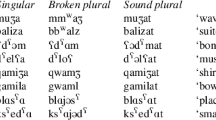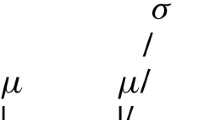Abstract
Word formation in Arabic has traditionally been assumed to involve interdigitation of a consonantal root with a vocalic pattern. This view is adopted by a large number of modern generative morphologists. More recently, however, several morphologists have argued that words in Semitic are formed from fully vocalised stems. In this paper, I argue that in San'ani (the dialect of San'a), and in some other Arabic dialects, there is a class of verbs that have as part of either their denotations or connotations a diminutive sense. I then consider diminutive nouns in the dialect. On the basis of semantic and phonological relationships between diminutive verbs and their non-diminutive counterparts, as well as native speakers' explanations of certain diminutive verbs, and the relationship between diminutive nouns and their non-diminutive counterparts, I argue that while some derivational processes take the root as the basic morphological unit, phonological and semantic similarities between certain stems can only be accounted for by derivation from a fully vocalised stem. I therefore conclude that both root-based and stem-based types of word formation occur.
Similar content being viewed by others
References
Al-Iryani M. (1996). Al-Mu’jam al-Yamany fi l-Lughat wa-t-Turath. Dar al-Fikr, Damascus
Al-Maqhafi I. A. (1985). Mu’jam al-Mudun wa-l-Qabaa’il al-Yamaniyyah. Dar al-Kalimah, San’a
Barbaresi, L. M. (2003). Diminutives. In W. F. Frawley, (Ed.), International encyclopedia of Linguistics (2nd ed. pp. 438–439). Oxford: Oxford University Press
Bat-El O. (1994). Stem modification and cluster transfer in Modern Hebrew. Natural Language and Linguistic Theory, 12: 571–596
Beckman, J. (1997). Positional faithfulness. PhD thesis, University of Massachusetts, Amherst
Burzio, L. (1999). Surface-to-surface morphology: when your representations turn into Constraints. Paper presented at the 1999 Maryland Mayfest, University of Maryland
Behnstedt, P. (1992). Die nordjemenitischen Dialekte. Teil 2: Glossar. Wiesbaden: Dr Ludwig Reichert
Dahl, Ö. (2006). Diminutives and augmentatives. In K. Brown (Ed.), The encyclopedia of language and linguistics (vol. 3, 2nd ed. pp. 594–595). London: Elsevier
Davis S., Zawaydeh B. (1999). A descriptive analysis of hypocoristics in Colloquial Arabic. Language and Linguistics, 3: 83–98
Dickins, J. (2006). An Arabic—English Dictionary of sudanese arabic. Pdf
Dickins, J. & Watson, J. C. E. (1999). Standard Arabic: an advanced course. Cambridge: Cambridge University Press
Diem, W. (1973). Skizzen jemenitischer Dialekte. Beirut: Franz Steiner
Dressler, W., & Merlini Barbaresi, L. (1994). Morphopragmatics: diminutives and intensifiers in Italian, German, and other languages. Berlin/New York: Mouton de Gruyter
Dressler, W., & Merlini Barbaresi, L. (2001). Morphopragmatics of diminutives and augmentatives: on the priority of pragmatics over semantics. In I. Kenesei & R.M. Harnish (Eds.), Perspectives on semantics, pragmatics and discourse: a festschrift for ferenc Kiefer (pp. 43–58). Amsterdam: Benjamins
Gafos, A. I. (2002). An argument for a stem-based view of Arabic morphology: Doubled verbs revisited. In D. B. Parkinson, & E. Benmamoun (Eds.), Perspectives on Arabic Linguistics (Vol. 13–14, pp. 59–86). Amsterdam: Benjamins
Hava, J. G. (1915). al-Fara’id al-Durriyyah fi al-Lughatayn al-’Arabiyyah wa-l-Inkiliziyyah. Beirut: Catholic Press
Heath, J. (1987). Ablaut and Ambiguity: phonology of a Moroccan Arabic dialect. Albany: State University of New York Press
Heath, J. (2002). Jewish and Muslim dialects of Moroccan Arabic. London: Curzon/Routledge
Hinds, M., & Badawi, El. S. (1986). A dictionary of Egyptian Arabic. Beirut: Librairie du Liban
Holes, C. (2001). Dialect, culture, and Society in Eastern Arabia. 1 Glossary. Leiden: Brill
Holes, C. (2004). Quadriliteral verbs in the Arabic dialects of Eastern Arabia. In M. Haak, R. de Jong, & K. Versteegh (Eds.), Approaches to Arabic dialects: a collection of articles presented to Manfred Woidich on the occasion of his 60th birthday (pp. 97–116). Brill: Leiden
Ibn Manzur, Muhammad ibn al-Mukarram (1955–1956). Lisan al-’Arab (15 Vols). Beirut: Dar al-Sadir
Johnstone, B. (1991). Repetition in Arabic: paradigms, syntagms and the ecology of language. Amsterdam: John Benjamins
Jurafsky D. (1996). Universal tendencies in the semantics of the diminutive. Language, 72: 533–578
Lass, R. (1997). Historical linguistics and language change. Cambridge: Cambridge University Press
McCarthy, J. J. (1981). A prosodic theory of nonconcatenative morphology. Linguistic Inquiry, 12, 373–418
McCarthy, J. J. (1982). Prosodic templates, morphemic templates and morphemic tiers. In H. van der Hulst & N. Smith (Eds.), The structure of phonological representations (Vol. 1, pp. 191–233).
McCarthy, J. J. (2000). Faithfulness and prosodic circumscription. In J. F. Dekkers, van der Leeuw, & J. van de Weijer (Eds.), Optimality theory: syntax, phonology and acquisition (pp. 151–189). Oxford: Oxford University Press
McCarthy, J. J. (2005). Optimal paradigms. In Downing, L., T. A. Hall & R. Rattelsiefen (Eds.), Paradigms in Phonological Theory (pp. 170–210). Oxford: Oxford University Press
McCarthy, J. J. & Prince, A. (1990a). Prosodic morphology and templatic morphology. In M. Eid, & J. J. McCarthy (Eds.), Perspectives on Arabic Linguistics 2 (pp. 1–54). Amsterdam: Benjamins
McCarthy, J. J. & Prince, A. (1990b). Foot and word in prosodic morphology: the Arabic broken plural. Natural Language and Linguistic Theory, 8, 209–283
McCarthy, J. J. & Prince, A. (1995). Faithfulness and reduplicative identity. In J. Beckman, L. Walsh Dickey, & Urbancsyk S. (Eds.), University of Massachusetts occasional Papers 18: Papers in optimality theory (pp. 249–384). Amherst: GLSA, University of Massachusetts
Mutahhar A-R., Watson J.C.E. (2002). Social issues in popular Yemeni culture. al-Sabahi Press, San’a
Piamenta M. (1990–1991). A dictionary of post-classical yemeni Arabic. Brill, Leiden
Prunet, J-F., Béland, R., & Idrissi, A. (2000). The mental representation of Semitic words. Linguistic Inquiry, 31, 609–648
Ratcliffe, R. R. (1997). Prosodic templates in a word-based morphological analysis of Arabic. In M. Eid, & Ratcliffe R. R. (Eds.), Perspectives on Arabic Linguistics 10 (pp. 147–171). Amsterdam: Benjamins
Ratcliffe, R. R. (1998). The ’Broken’ Plural Problem in Arabic and Comparative Semitic: Allomorphy and analogy in non-concatenative morphology. Amsterdam: John Benjamins
Soudi, A, Cavalli-Sforza, V., & Jamari, A. (n.d.) A computational lexeme-based treatment of Arabic morphology. Pdf
Stawnicka, J. (2001). Deminutywa werbalne w jazyku rosyjskim i ich ekwiwalenty w jazyku niemieckim. [The diminutive verbs in Russian and their equivalents in German]. In O. Propo-pczuk (Ed.), Wschód – Zachód Pogranicze Kultur: Kultura – Literaturoznawstwo – Jazykoz- nawstwo, (pp. 332–336). Slupsk
Ussishkin A.P. (1999). The inadequacy of the consonantal root: Modern Hebrew and output–output correspondence. Phonology, 16: 401–442
Ussishkin A.P. (2005). A fixed prosodic theory of nonconcatenative templatic morphology. Natural Language and Linguistic Theory, 23: 169–218
Watson, J. C. E. (2002). The phonology and morphology of Arabic. Oxford: Oxford University Press
Wehr, H. (1961). A dictionary of modern written Arabic. Wiesbaden: Harrassowitz
Woidich, M. (2006). Grammatik des Kairenisch-Arabischen. Wiesbaden: Harrassowitz
Wright, W. (1975). A grammar of the Arabic Language. Cambridge: Cambridge University Press
Yoda, S. (2005). The Arabic dialect of the Jews of Tripoli (Libya): Grammar, text and glossary. Wiesbaden: Harrassowitz
Author information
Authors and Affiliations
Corresponding author
Rights and permissions
About this article
Cite this article
Watson, J.C.E. Arabic morphology: diminutive verbs and diminutive nouns in San’ani Arabic. Morphology 16, 189–204 (2006). https://doi.org/10.1007/s11525-006-9103-5
Received:
Accepted:
Published:
Issue Date:
DOI: https://doi.org/10.1007/s11525-006-9103-5




